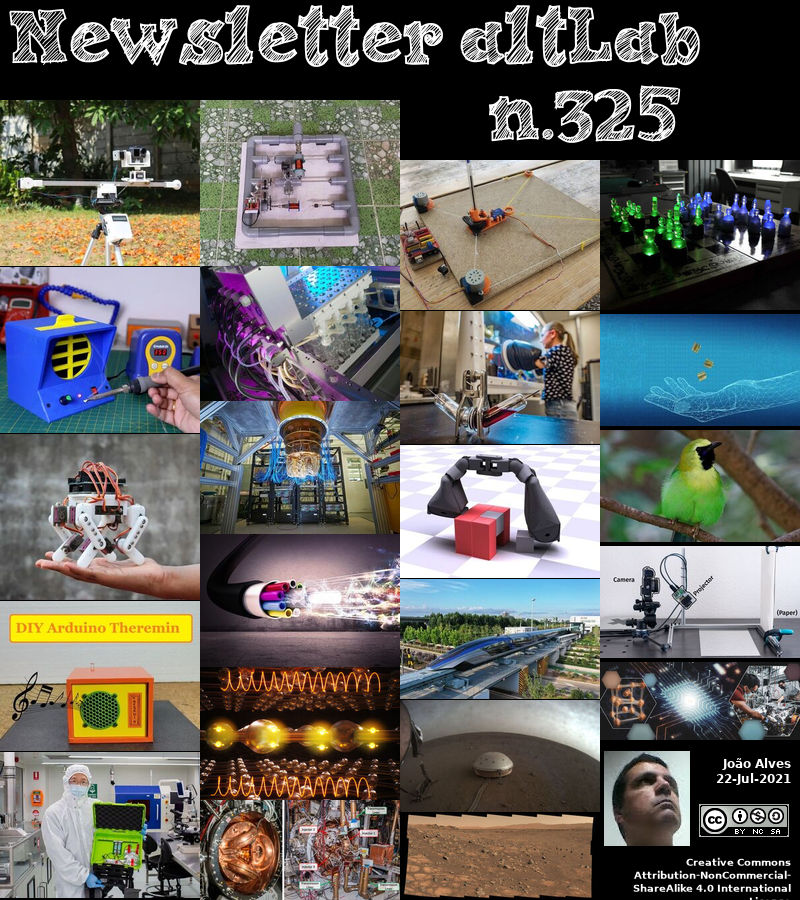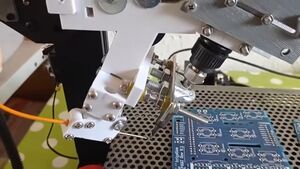2021-07-22 - Nº 325
Editorial
Esta é a Newsletter Nº 325 que se apresenta com o mesmo formato que as anteriores. Se gostar da Newsletter partilhe-a!
Todas as Newsletters encontram-se indexadas no link.
Esta Newsletter tem os seguintes tópicos:
Faz hoje anos que nascia, em 1784, o astrónomo alemão Friedrich Bessel. Ele passou toda a sua carreira desde os 26 anos de idade (nomeado 1809) como director de Frederick William III do novo Observatório Königsberg da Prússia e professor de astronomia. A sua tarefa monumental era determinar as posições e os movimentos adequados para cerca de 50.000 estrelas, o que permitiu a primeira determinação precisa das distâncias interestelares. O trabalho de Bessel na determinação das constantes de pré-cessão, nutação e aberração ganhou-lhe mais honras. Para além do sol, foi o primeiro a medir a distância de uma estrela, por paralaxe, de 61 Cygni (1838). Na análise matemática, ele é conhecido pela sua função de Bessel.
Faz também hoje anos que nascia, em 1887, o físico quântico alemão Gustav Ludwig Hertz. Ele, com James Franck, recebeu o Prémio Nobel da Física em 1925 pela experiência Franck-Hertz, que confirmou a teoria quântica de que a energia só pode ser absorvida por um átomo em quantidades definidas e forneceu uma importante confirmação do modelo atómico de Bohr. Era um sobrinho de Heinrich Hertz.
Em 1894 era realizada a primeira corrida de carros entre cidades, entre Paris e Rouen em França. É considerada a primeira corrida automóvel competitiva.
Nesta semana que passou, a Blue Origin completou com sucesso o primeiro voo humano da New Shepard com quatro cidadãos a bordo. A tripulação incluía Jeff Bezos, Mark Bezos, Wally Funk e Oliver Daemen, que se tornaram todos oficialmente astronautas quando passaram a Linha Kármán, a fronteira do espaço reconhecida internacionalmente. Wally Funk, 82 anos, tornou-se a pessoa mais velha a voar no espaço. Oliver Daemen, 18 anos, foi o primeiro astronauta comercial de sempre a comprar um bilhete e a voar para o espaço num veículo espacial privado e licenciado a partir de um local de lançamento privado. Tornou-se também a pessoa mais jovem a voar no espaço. O New Shepard tornou-se o primeiro veículo comercial sob uma licença de veículo de lançamento reutilizável suborbital a voar clientes pagantes, tanto de carga útil como de astronauta, para o espaço e de volta. Jeff e Mark Bezos tornaram-se os primeiros irmãos a voar juntos no espaço.
Na Newsletter desta semana apresentamos diversas noticias, artigos científicos, projetos de maker assim como alguns videos interessantes.
 João Alves ([email protected])
João Alves ([email protected])
O conteúdo da Newsletter encontra-se sob a licença  Creative Commons Attribution-NonCommercial-ShareAlike 4.0 International License.
Creative Commons Attribution-NonCommercial-ShareAlike 4.0 International License.
Novidades da Semana
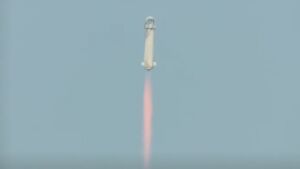
Blue Origin safely launches four commercial astronauts to space and back
"Blue Origin successfully completed New Shepard’s first human flight today with four private citizens onboard. The crew included Jeff Bezos, Mark Bezos, Wally Funk and Oliver Daemen, who all officially became astronauts when they passed the Kármán Line, the internationally recognized boundary of space. Upon landing, the astronauts were greeted by their families and Blue Origin’s ground operations team for a celebration in the West Texas desert. A Historic Mission Wally Funk, 82, became the oldest person to fly in space. Oliver Daemen, 18, was the first ever commercial astronaut to purchase a ticket and fly to space on a privately-funded and licensed space vehicle from a private launch site. He also became the youngest person to fly in space." [...]
Outras Notícias

World's speediest 600 km/h maglev rolls off assembly line in E.China’s Qingdao
"China's self-developed and the world's fastest maglev transportation system with a speed of 600 kilometers per hour rolled off the assembly line on Tuesday in Qingdao, East China's Shandong Province, marking another crucial milestone in the country's rapid rise as a global leader in high-speed rail technology and manufacturing and in its broad, ambitious goals to accelerate urbanization and build a modern socialist power. The maglev train can fill the gap between the current high-speed train that runs at around 350 km/h and airplanes with a speed of 800 km/h, which will support China's comprehensive transportation network planned by 2035, analysts noted. The maglev train is currently the fastest available ground vehicle. It is the fastest method of surface transportation within the range of 1,500 kilometers, according to a report by the CRRC sent to the Global Times on Tuesday. What is currently a 10-hour high-speed train trip from South China's Shenzhen to Shanghai will be shortened to only 2.5 hours once a maglev train is built. The new maglev train showcases a number of technological breakthroughs and advances, including a self-developed brake system that is 30 percent more efficient than the Shanghai maglev train, which means that the braking distance is reduced from about 16 kilometers to 10 kilometers, CRRC Qingdao Sifang Rolling Stock Research Institute (CRRC SRI) told the Global Times on Tuesday." [...]

Data transmission speed record clocks blistering 319 Terabits per second
"The world record for fastest internet speed has been utterly shattered as Japanese engineers have demonstrated a data transmission rate of 319 Terabits per second (Tb/s) through optical fibers. The record was set over more than 3,000 km (1,864 miles) of fibers, and is apparently compatible with existing cable infrastructure. It’s hard to overstate just how incredibly fast that transmission speed is. It’s almost twice the previous record of 178 Tb/s, set less than a year ago, and seven times faster than the record before that – 44.2 Tb/s from an experimental photonic chip. NASA gets by with “only” 400 Gb/s, and it absolutely demolishes speeds currently available to consumers: the fastest home internet connections top out at 10 Gb/s in parts of Japan, New Zealand and the US. The breakthrough was achieved using existing fiber optic infrastructure, with more advanced technologies added on." [...]
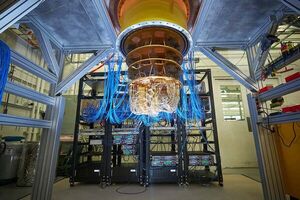
Google demonstrates vital step towards large-scale quantum computers
"Google has shown that its Sycamore quantum computer can detect and fix computational errors, an essential step for large-scale quantum computing, but its current system generates more errors than it solves. Error-correction is a standard feature for ordinary, or classical, computers, which store data using bits with two possible states: 0 and 1. Transmitting data with extra “parity bits” that warn if a 0 has flipped to 1, or vice versa, means such errors can be found and fixed. In quantum computing the problem is far more complex as each quantum bit, or qubit, exists in a mixed state of 0 and 1, and any attempt to measure them directly destroys the data. One longstanding theoretical solution to this has been to cluster many physical qubits into a single “logical qubit”. Although such logical qubits have been created previously, they hadn’t been used for error correction until now." [...]
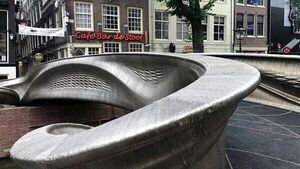
The world's first 3D-printed steel bridge has opened in Amsterdam
"The world’s first 3D-printed steel footbridge has been unveiled in Amsterdam - and it's packed with cutting-edge sensors that measure in real-time how it handles pedestrian traffic. It was installed over one of the oldest canals in the city's Red Light District and inaugurated by Dutch Queen Maxima on Thursday. Designed by Dutch designer Joris Laarman, the 12-metre futuristic structure was created with a type of 3D printing technique using welding robots. MX3D, the company that developed the technology, said the elaborate design of the bridge showcases the possibilities of robotic 3D printing in architecture. "If you want to have a really highly decorated bridge or a really aesthetic bridge, suddenly it becomes a good option to print it, because it's not just about making things cheaper and more efficient," said Tim Geurtjens, who developed the MX3D technology. Smart design The bridge doesn't simply look eye-catching, it's also built to be smart." [...]

PlasticArm: Realizing the full potential of the Internet of Things
"Microprocessors have undergone an unbelievable period of transformation across just a few decades. The world’s first commercially produced processor was a modest 4-bit central processing unit (CPU) with 2,300 transistors. It was fabricated in 10µm process technology in silicon and capable only of simple arithmetic calculations. Nowadays, state-of-the-art silicon 64-bit microprocessors have 30 billion transistors – such as the AWS Graviton2 microprocessor fabricated using a 7nm process. Such sophisticated technology has enabled the development of powerful devices for large and small-scale applications across many industries. But could there be instances where this silicon is unsuitable?" [...]
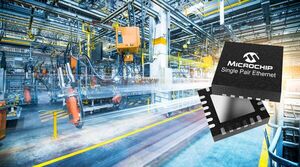
New Ethernet PHYs Enable Multidrop Bus Architecture, Enhancing Industrial Networks’ Scalability and Functionality
"Microchip’s LAN867x family of Ethernet PHYs is the first to implement the IEEE® 10BASE-T1S single-pair Ethernet technology standard for connecting devices in industrial networks Smart manufacturing is driving efficiencies in automation as digital networks increasingly connect machines, production line equipment and robotics. Operational Technology (OT) and Information Technology (IT) networks that are critical to the Industrial Internet of Things (IIoT) rely on Ethernet for interoperability and to speed data transmission and ensure security. The LAN867x family of 10BASE-T1S PHYs, a new solution available today from Microchip Technology Inc. (Nasdaq: MCHP), expands Ethernet connectivity to the very edges of industrial networks, simplifying architectures and reducing risk for designers. Microchip’s LAN867x Ethernet Physical Layer (PHY) transceivers are high-performance, small-footprint devices enabling connections to standard system devices including sensors and actuators that previously required their own communication systems. With the LAN867x devices, all-Ethernet infrastructures in OT and IT systems can be expanded to the edges of the network. Microchip’s LAN867x devices eliminate the need for gateways that in the past were needed to interconnect incompatible communication systems." [...]

Maxim Integrated’s Hand-Held Camera Cube Reference Design Enables Artificial Intelligence at the Edge for Vision and Hearing Applications
"Today Maxim Integrated Products, Inc. (NASDAQ: MXIM) unveiled the MAXREFDES178# camera cube reference design, which demonstrates how Artificial intelligence (AI) applications previously limited to machines with large power and cost budgets can be embedded in space-constrained, battery-powered edge devices. The MAXREFDES178# enables ultra-low-power internet of things (IoT) devices to implement hearing and vision and showcases the MAX78000 low-power microcontroller with neural network accelerator for audio and video inferences. The system also contains the MAX32666 ultra-low power Bluetooth® microcontroller and two MAX9867 audio CODECs. The entire system is delivered in an ultra-compact form factor to show how AI applications such as facial identification and keyword recognition can be embedded in low-power, cost-sensitive applications such as wearables and IoT devices. AI applications require intensive computations, usually performed in the cloud or in expensive, power-hungry processors that can only fit in applications with big power budgets such as self-driving cars. But the MAXREFDES178# camera cube demonstrates how AI can live on a low-power budget, enabling applications that are time- and safety-critical to operate on even the smallest of batteries." [...]
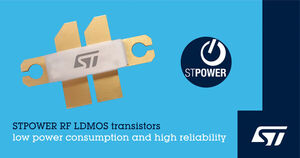
STMicroelectronics Introduces New RF LDMOS Power Transistors
"STMicroelectronics is adding a broad range of new devices to the STPOWER family of LDMOS transistors, which comprises three different product series optimized for RF power amplifiers (PAs) in a variety of commercial and industrial applications. Featuring high efficiency and low thermal resistance and packaged to handle high RF power, STPOWER LDMOS devices combine a short conduction-channel length with a high breakdown voltage. These characteristics permit a cost-effective solution with low power consumption and high reliability. Expanding the range of applications that can be addressed, the new STPOWER LDMOS IDCH and IDDE series are 28V/32V common-source N-channel enhancement-mode lateral field-effect RF power transistors. IDCH devices provide output power from 8W to 300W and are specifically designed for applications up to 4GHz, including 2.45GHz industrial, scientific, and medical (ISM), wireless infrastructure, satellite communications, and avionics and radar equipment. The LDMOS devices are suitable for all types of modulation formats." [...]

Renesas Launches R-Car Gen3e With Up to 20 Percent Higher CPU Speed for Automotive Infotainment, Cockpit, and Digital Cluster Systems
"New SoCs Add 2GHz Speeds, Higher Application Integration, Increased Functional Safety for Entry- to Mid-Range Systems with Maximum Scalability and Software Re-Use from R-Car Gen3 Renesas Electronics Corporation (TSE:6723), a premier supplier of advanced semiconductor solutions, today added a new family to its popular series of R-Car system-on-chips (SoCs) with the R-Car Gen3e. Featuring six new members, the new R-Car Gen3e series of SoCs offers a scalable lineup for entry- to mid-range automotive applications that require high-quality graphics rendering, such as integrated cockpit domain controllers, in-vehicle infotainment (IVI), digital instrument cluster, driver monitoring systems, and LED matrix light. The new devices extend the successful R-Car Gen3 SoC products with increased CPU performance up to 50k DMIPS and 2GHz speeds to help carmakers navigate demands for continuous user experience, security, and safety improvements. Renesas provides Winning Combination solutions featuring the R-Car Gen3e devices to shorten development time and reduce bill of materials (BOM) costs. Customers can combine the R-Car Gen3e devices with Renesas’ high-accuracy timing ICs, power management products. “With the growing popularity of applications such as augmented reality navigation and AI-based digital automotive assistants, OEMs and Tier 1s need to balance the skyrocketing demand for larger, higher resolution displays and high-performance chips with rising BOM costs and longer development times, ” said Naoki Yoshida, Vice President Automotive Digital Products Marketing at Renesas." [...]

Microchip Announces Production Shipments of Industry’s First NVMe and 24G SAS Tri-mode RAID and HBA Storage Adapters
"Adaptec® Smart Storage Adapters Provide Increased Performance, Security and Scalability While Simplifying Storage Management Cloud service providers and server original equipment manufacturers (OEMs) designing storage platforms demand exceptional performance, flexibility and security for the next generation of data centers. Microchip Technology Inc. (Nasdaq: MCHP) today announced the Adaptec® Smart Storage PCIe® Gen 4 NVMe Tri-Mode SmartRAID 3200 RAID Adapters, and Adaptec SmartHBA 2200 and Adaptec HBA 1200 Host Bus Adapters. These adapters enable next-generation NVMe and 24G SAS connectivity and manageability with market- leading performance while delivering new levels of security required for next-generation data center infrastructure. "Our new Adaptec Tri-Mode storage adapters deliver the performance, connectivity, security and ease of management that our cloud and server OEM customers require for their latest PCIe Gen 4-based server storage solutions,” said Andrew Dieckmann, associate vice president of product marketing for Microchip’s data center solutions business unit. “These adapters set a new benchmark in the industry for storage adapter security and performance with the latest NVMe and 24G SAS media, as well as flexibility for supporting 12G SAS and 6G SATA SSDs and HDDs.” “Our Cloud and Enterprise customers demand that storage systems move vast data sets efficiently and reliably at speed,” said Greg Matson, senior director, Strategic Planning and Product Marketing, Intel® NPSG. “Supporting x8 and x16 PCIe Gen 4 with up to 4x performance improvement over previous generations, Microchip’s newest Smart Storage adapters, when paired with Intel’s latest TLC and QLC PCIe 3D NAND SSDs, help improve the performance of high-density storage solutions.” “Our NVMe and SAS/SATA infrastructure innovations are delivering the media flexibility, dependability and scalability to hit the performance and cost targets customers are demanding,” said Sangyeun Cho, senior vice president of the Memory Software Development Team at Samsung Electronics." [...]

NASA Perseverance Mars Rover to Acquire First Sample
"NASA is making final preparations for its Perseverance Mars rover to collect its first-ever sample of Martian rock, which future planned missions will transport to Earth. The six-wheeled geologist is searching for a scientifically interesting target in a part of Jezero Crater called the “Cratered Floor Fractured Rough.” This important mission milestone is expected to begin within the next two weeks. Perseverance landed in Jezero Crater Feb. 18, and NASA kicked off the rover mission’s science phase June 1, exploring a 1.5-square-mile (4-square-kilometer) patch of crater floor that may contain Jezero’s deepest and most ancient layers of exposed bedrock. “When Neil Armstrong took the first sample from the Sea of Tranquility 52 years ago, he began a process that would rewrite what humanity knew about the Moon,” said Thomas Zurbuchen, associate administrator for science at NASA Headquarters. “I have every expectation that Perseverance’s first sample from Jezero Crater, and those that come after, will do the same for Mars. We are on the threshold of a new era of planetary science and discovery.” It took Armstrong 3 minutes and 35 seconds to collect that first Moon sample." [...]
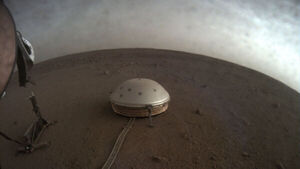
NASA’s InSight Reveals the Deep Interior of Mars
"Three papers published today share new details on the crust, mantle, and molten core of the Red Planet. Before NASA’s InSight spacecraft touched down on Mars in 2018, the rovers and orbiters studying the Red Planet concentrated on its surface. The stationary lander’s seismometer has changed that, revealing details about the planet’s deep interior for the first time. Three papers based on the seismometer’s data were published today in Science, providing details on the depth and composition of Mars’ crust, mantle, and core, including confirmation that the planet’s center is molten. Earth’s outer core is molten, while its inner core is solid; scientists will continue to use InSight’s data to determine whether the same holds true for Mars. “When we first started putting together the concept of the mission more than a decade ago, the information in these papers is what we hoped to get at the end,” said InSight’s principal investigator Bruce Banerdt of NASA’s Jet Propulsion Laboratory in Southern California, which leads the mission." [...]

Developing the first ICs to orbit Earth
"For Charles “Bob” Cook, a project assigned by Jack Kilby led to the development of the first integrated circuits to ever orbit the Earth – and a foundation for future space electronics Jack Kilby was a little more than two years removed from inventing the integrated circuit (IC) when he was promoted to lead the fledgling semiconductor lab at our company. The year was 1961. He was working on three high-profile contracts – and all were having issues. He was entrusted with making custom ICs for the Minuteman missile guidance system and ICs for a U.S. Air Force computer system. The third project was a particularly challenging request from NASA – and Jack knew exactly who he wanted to lead the project. Charles “Bob” Cook was a young but brilliant engineer who had a knack for trouble-shooting semiconductors." [...]

Russia launches Nauka module to International Space Station
"Russia launched a long-delayed module for its segment of the International Space Station July 21, but that module reportedly suffered technical problems after reaching orbit. A Proton-M rocket lifted off from the Baikonur Cosmodrome at 10:58 a.m. Eastern carrying the Multipurpose Laboratory Module, or Nauka. The module separated from the rocket’s upper stage about nine and a half minutes after launch. Both Roscosmos and NASA said that Nauka deployed its solar arrays and navigational antennas shortly after separation. Neither agency has provided additional updates on the status of Nauka, but Russian industry sources, posting online, claimed that the module suffered several problems after reaching orbit. Those problems included the inability to confirm that an antenna and docking target deployed as expected, as well as issues with infrared sensors and thrusters." [...]
Ciência e Tecnologia
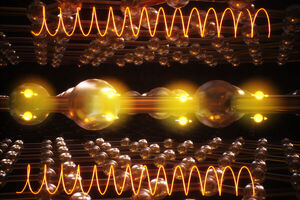
“Magic-angle” trilayer graphene may be a rare, magnet-proof superconductor
"New findings might help inform the design of more powerful MRI machines or robust quantum computers. MIT physicists have observed signs of a rare type of superconductivity in a material called magic-angle twisted trilayer graphene. In a study appearing today in Nature, the researchers report that the material exhibits superconductivity at surprisingly high magnetic fields of up to 10 Tesla, which is three times higher than what the material is predicted to endure if it were a conventional superconductor. The results strongly imply that magic-angle trilayer graphene, which was initially discovered by the same group, is a very rare type of superconductor, known as a “spin-triplet,” that is impervious to high magnetic fields. Such exotic superconductors could vastly improve technologies such as magnetic resonance imaging, which uses superconducting wires under a magnetic field to resonate with and image biological tissue. MRI machines are currently limited to magnet fields of 1 to 3 Tesla." [...]

No Stone Unturned: An Extensive Search for Cation Substitution in Lithium-ion Batteries
"Scientists demonstrate an inexpensive computational technique to screen for atomic substitutions in lithium-ion batteries to boost their capacity Lithium-ion batteries (LIBs) power all of modern-day electronic devices. However, with the shift from gasoline-powered vehicles to electric counterparts, there is a demand for higher battery capacity. In their quest for higher battery capacity, scientists from Japan devised a low-cost computational technique for extensively screening for atomic substitutions in LIBs to improve their discharge capacity, opening doors to the development of novel alloying materials to boost battery life and new energy storage systems. Powering everything from smartphones to electric cars, lithium-ion batteries (LIBs) have evolved markedly with advances in technology and revolutionized our world. The next step in the progress of technology is developing even better batteries to power electronic devices for longer durations. One promising technique for increasing battery performance involves the atomic substitution of positively charged ions or "cations" in the cathode material." [...]
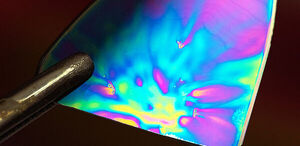
Sweet spot for membrane thickness offers sustainable separations
"Perfecting the dimensions of chemical separation membranes is a step toward a sustainable chemical industry. Super-thin carbon molecular sieve (CMS) membranes may not be best for separating industrially important chemical mixtures. However, ensuring the CMS film thickness is just right could enable more energy-efficient purification of chemical products, KAUST researchers have shown. CMS membranes, as their name suggests, can purify mixtures of liquids or gases by permitting only certain molecules to pass through their subnanometer-sized pores. Currently, the chemical industry mainly uses heat-based processes such as distillation to separate product mixtures, but these processes consume about 10 percent of global energy output. “This situation is highly unsustainable,” says Wojciech Ogieglo, a research scientist at KAUST." [...]

Can optical structures in feathers of a bird spawn a technology revolution?
"For years engineers have struggled to create in a usable form a structure known as a gyroid, a peculiar multi-surface object that can both reflect light and conduct electricity and just may hold the key to a host of photonics-related technologies, from advanced solar panels to fuel cells. Yale researchers have found a possible solution to this challenge in the wing of a bird. A new Yale video highlights a discovery made by a team of researchers — including Vinod Kumar Saranathan, a senior research fellow at Yale-NUS College, and Richard Prum, William Robertson Coe Professor of Ornithology at Yale — and its potential implications for the future of technology. " [...]
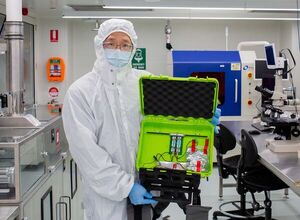
Mini radar could scan the Moon for water and habitable tunnels
"A miniature device that scans deep below ground is being developed to identify ice deposits and hollow lava tubes on the Moon for possible human settlement. The prototype device, known as MAPrad, is just one tenth the size of existing ground penetrating radar systems, yet can see almost twice as deeply below ground – more than 100 metres down – to identify minerals, ice deposits, or voids such as lava tubes. Local start-up CD3D PTY Limited has now received a grant from the Australian Space Agency’s Moon to Mars initiative to further develop the prototype with RMIT University, including testing it by mapping one of Earth’s largest accessible systems of lava tubes. CD3D CEO and RMIT Honorary Professor, James Macnae, said their unique geophysical sensor had several advantages over existing technology that made it more suitable for space missions. “MAPrad is smaller, lighter and uses no more power than existing ground penetrating radar devices, yet can see up to hundreds of meters below the surface, which is around twice as deep as existing technology,” Macnae said. “It was able to achieve this improved performance, even after being shrunken to a hand-held size, because it operates in a different frequency range: using the magnetic rather than the electric component of electromagnetic waves.” The magnetic waves emitted and detected by the device measure conductivity and electromagnetic wave reflections to identify what lies underground." [...]
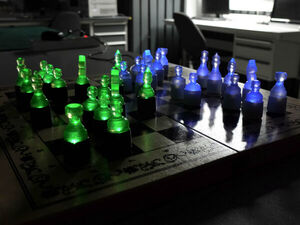
ITMO Researchers Create Perovskite Chess Set That Glows in the Dark
"For today’s International Chess Day, a research team from ITMO’s School of Physics and Engineering presents a unique device – a chess set with light-emitting pieces that contain perovskite. The energy is delivered wirelessly into each piece using a special transmitter embedded into the chessboard. Among specialists of the school who took part in the project are Sergey Makarov, Lev Zelenkov, Eduard Danilovsky, Polina Kapitanova, Pavel Smirnov, and Georgy Baranov, as well as two first-year students of the Applied and Theoretical Physics program – Aidar Rakhmatullin and Tatyana Filimonova. Thanks to them, the pieces were produced and the final setup assembled. According to the creators, they came up with the idea together, but Sergey Makarov, a big fan of chess, initiated it. However, this game is popular at the faculty in general and tournaments are often held between staff and students." [...]

Novel research revealing how a unique sponge “goes with the flow” could improve man-made structures
"Collaborative project including NYU Tandon researcher Maurizio Porfiri taps one of the world’s most powerful supercomputers to reveal the water-bending skills of the Venus' flower basket sponge. Insights could have implications for man-made craft and structures. The remarkable structural properties of the Venus' flower basket sponge (E. aspergillum) might seem fathoms removed from human-engineered structures. However, insights into how the organism’s latticework of holes and ridges influences the hydrodynamics of seawater in its vicinity could lead to advanced designs for buildings, bridges, marine vehicles and aircraft, and anything that must respond safely to forces imposed by the flow of air or water. While past research has investigated the structure of the sponge, there have been few studies of the hydrodynamic fields surrounding and penetrating the organism, and whether, besides improving its mechanical properties, the skeletal motifs of E. Aspergillum underlie the optimization of the flow physics within and beyond its body cavity. A collaboration across three continents at the frontiers of physics, biology, and engineering co-led by Maurizio Porfiri at the NYU Tandon School of Engineering, applied super computational muscle and special software to gain a deeper understanding of these interactions, creating a first-ever simulation of the deep-sea sponge and how it responds to and influences the flow of nearby water." [...]

Smartphone screens effective sensors for soil or water contamination
"The touchscreen technology used in billions of smartphones and tablets could also be used as a powerful sensor, without the need for any modifications. Researchers from the University of Cambridge have demonstrated how a typical touchscreen could be used to identify common ionic contaminants in soil or drinking water by dropping liquid samples on the screen, the first time this has been achieved. The sensitivity of the touchscreen sensor is comparable to typical lab-based equipment, which would make it useful in low-resource settings. The researchers say their proof of concept could one day be expanded for a wide range of sensing applications, including for biosensing or medical diagnostics, right from the phone in your pocket. The results are reported in the journal Sensors and Actuators B. Touchscreen technology is ubiquitous in our everyday lives: the screen on a typical smartphone is covered in a grid of electrodes, and when a finger disrupts the local electric field of these electrodes, the phone interprets the signal. Other teams have used the computational power of a smartphone for sensing applications, but these have relied on the camera or peripheral devices, or have required significant changes to be made to the screen." [...]
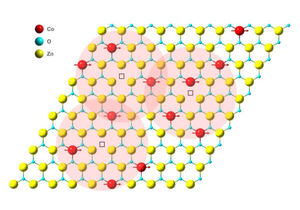
Scientists Create World’s Thinnest Magnet
"A one-atom-thin 2D magnet developed by Berkeley Lab and UC Berkeley could advance new applications in computing and electronics The development of an ultrathin magnet that operates at room temperature could lead to new applications in computing and electronics – such as high-density, compact spintronic memory devices – and new tools for the study of quantum physics. The ultrathin magnet, which was recently reported in the journal Nature Communications, could make big advances in next-gen memory devices, computing, spintronics, and quantum physics. It was discovered by scientists at the Department of Energy’s Lawrence Berkeley National Laboratory (Berkeley Lab) and UC Berkeley. “We’re the first to make a room-temperature 2D magnet that is chemically stable under ambient conditions,” said senior author Jie Yao, a faculty scientist in Berkeley Lab’s Materials Sciences Division and associate professor of materials science and engineering at UC Berkeley. “This discovery is exciting because it not only makes 2D magnetism possible at room temperature, but it also uncovers a new mechanism to realize 2D magnetic materials,” added Rui Chen, a UC Berkeley graduate student in the Yao Research Group and lead author on the study. The magnetic component of today’s memory devices is typically made of magnetic thin films." [...]
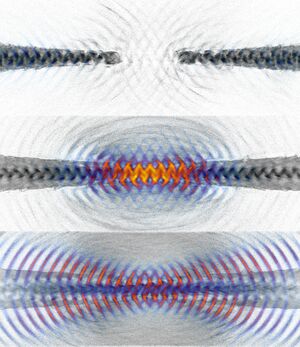
Antimatter from laser pincers
"Research team develops new method to study astrophysical processes in the laboratory In the depths of space, there are celestial bodies where extreme conditions prevail: Rapidly rotating neutron stars generate super-strong magnetic fields. And black holes, with their enormous gravitational pull, can cause huge, energetic jets of matter to shoot out into space. An international physics team with the participation of the Helmholtz-Zentrum Dresden-Rossendorf (HZDR) has now proposed a new concept that could allow some of these extreme processes to be studied in the laboratory in the future: A special setup of two high-intensity laser beams could create conditions similar to those found near neutron stars. In the discovered process, an antimatter jet is generated and accelerated very efficiently. The experts present their concept in the journal Communications Physics (DOI: 10.1038/s42005-021-00636-x). The basis of the new concept is a tiny block of plastic, crisscrossed by micrometer-fine channels." [...]

Contact-aware robot design
"A novel method to represent robotic manipulators helps optimize complex and organic shapes for future machines. Adequate biomimicry in robotics necessitates a delicate balance between design and control, an integral part of making our machines more like us. Advanced dexterity in humans is wrapped up in a long evolutionary tale of how our fists of fury evolved to accomplish complex tasks. With machines, designing a new robotic manipulator could mean long, manual iteration cycles of designing, fabricating, and evaluating guided by human intuition. Most robotic hands are designed for general purposes, as it’s very tedious to make task-specific hands. Existing methods battle trade-offs between the complexity of designs critical for contact-rich tasks, and the practical constraints of manufacturing, and contact handling." [...]

Unconventional Superconductor Acts the Part of a Promising Quantum Computing Platform
"Scientists on the hunt for an unconventional kind of superconductor have produced the most compelling evidence to date that they’ve found one. In a pair of papers, researchers at the University of Maryland’s (UMD) Quantum Materials Center (QMC) and colleagues have shown that uranium ditelluride (or UTe2 for short) displays many of the hallmarks of a topological superconductor—a material that may unlock new ways to build quantum computers and other futuristic devices. “Nature can be wicked,” says Johnpierre Paglione, a professor of physics at UMD, the director of QMC and senior author on one of the papers. “There could be other reasons we're seeing all this wacky stuff, but honestly, in my career, I've never seen anything like it.” All superconductors carry electrical currents without any resistance. It’s kind of their thing. The wiring behind your walls can’t rival this feat, which is one of many reasons that large coils of superconducting wires and not normal copper wires have been used in MRI machines and other scientific equipment for decades." [...]

Scientists take first snapshots of ultrafast switching in a quantum electronic device
"They discover a short-lived state that could lead to faster and more energy-efficient computing devices. Electronic circuits that compute and store information contain millions of tiny switches that control the flow of electric current. A deeper understanding of how these tiny switches work could help researchers push the frontiers of modern computing. Now scientists have made the first snapshots of atoms moving inside one of those switches as it turns on and off. Among other things, they discovered a short-lived state within the switch that might someday be exploited for faster and more energy-efficient computing devices. The research team from the Department of Energy’s SLAC National Accelerator Laboratory, Stanford University, Hewlett Packard Labs, Penn State University and Purdue University described their work in a paper published in Science today." [...]
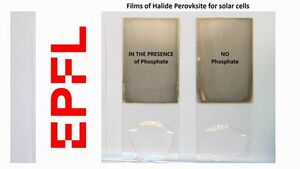
Removing the lead hazard from perovskite solar cells
"Although a very promising solution for capturing solar energy, perovskite solar cells contain lead, which is toxic to the environment and a serious health hazard. EPFL scientists have now found a very elegant and efficient solution by adding a transparent phosphate salt that doesn’t interfere with light-conversion efficiency while preventing lead from seeping into the soil in cases of solar panel failure. “The solar energy-to-electricity conversion of perovskite solar cells is unbelievably high, around 25%, which is now approaching the performance of the best silicon solar cells,” says Professor László Forró at EPFL’s School of Basic Sciences. “But their central element is lead, which is a poison; if the solar panel fails, it can wash out into the soil, get into the food chain, and cause serious diseases.” The problem is that in most of the halide perovskites lead can dissolve in water. This water solubility and solubility in other solvents is actually a great advantage, as it makes building perovskite solar panels simpler and inexpensive – another perk along with their performance. But the water solubility of lead can become a real environmental and health hazard when the panel breaks or gets wet, e.g." [...]
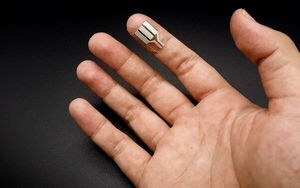
Calling all couch potatoes: this finger wrap can let you power electronics while you sleep
"A new wearable device turns the touch of a finger into a source of power for small electronics and sensors. Engineers at the University of California San Diego developed a thin, flexible strip that can be worn on a fingertip and generate small amounts of electricity when a person’s finger sweats or presses on it. What’s special about this sweat-fueled device is that it generates power even while the wearer is asleep or sitting still. This is potentially a big deal for the field of wearables because researchers have now figured out how to harness the energy that can be extracted from human sweat even when a person is not moving. This type of device is the first of its kind, said co-first author Lu Yin, a nanoengineering Ph.D. student at the UC San Diego Jacobs School of Engineering. “Unlike other sweat-powered wearables, this one requires no exercise, no physical input from the wearer in order to be useful." [...]
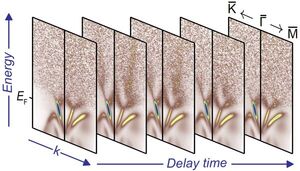
Future information technologies: Topological materials for ultrafast spintronics
"A team led by HZB physicist Dr. Jaime Sánchez-Barriga has gained new insights into the ultrafast response of topological states of matter to femtosecond laser excitation. Using time- and spin-resolved methods at BESSY II, the physicists explored how, after optical excitation, the complex interplay in the behavior of excited electrons in the bulk and on the surface results in unusual spin dynamics. The work is an important step on the way to spintronic devices based on topological materials for ultrafast information processing. The laws of quantum physics rule the microcosm. They determine, for example, how easily electrons move through a crystal and thus whether the material is a metal, a semiconductor or an insulator. Quantum physics may lead to exotic properties in certain materials: In so-called topological insulators, only the electrons that can occupy some specific quantum states are free to move like massless particles on the surface, while this mobility is completely absent for electrons in the bulk." [...]

University of Maryland Engineers Have 3D Printed a Soft Robotic Hand That Can Play Nintendo
"A team of researchers from the University of Maryland has 3D printed a soft robotic hand that is agile enough to play Nintendo’s Super Mario Bros.—and win! The feat, highlighted on the front cover of the latest issue of Science Advances, demonstrates a promising innovation in the field of “soft robotics”, which centers on creating new types of flexible, inflatable robots that are powered using water or air rather than electricity. Soft robots’ inherent safety and adaptability has sparked interest in their use for applications like prosthetics and biomedical devices. Unfortunately, controlling the fluids that make these soft robots bend and move has been especially difficult—until now. The key breakthrough by the team, led by University of Maryland assistant professor of mechanical engineering Ryan D. Sochol, was the ability to 3D print fully assembled soft robots with “integrated fluidic circuits” in a single step. “Previously, each finger of a soft robotic hand would typically need its own control line, which can limit portability and usefulness,” explains co-first author Joshua Hubbard, who performed the research during his time as an undergraduate researcher in Sochol’s Bioinspired Advanced Manufacturing (BAM) Laboratory at UMD." [...]
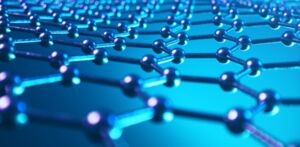
The mathematics of repulsion for new graphene catalysts
"A new mathematical model helps predict the tiny changes in carbon-based materials that could yield interesting properties. Scientists at Tohoku University and colleagues in Japan have developed a mathematical model that abstracts the key effects of changes to the geometries of carbon material and predicts its unique properties. The details were published in the journal Carbon. Scientists generally use mathematical models to predict the properties that might emerge when a material is changed in certain ways. Changing the geometry of three-dimensional (3D) graphene, which is made of networks of carbon atoms, by adding chemicals or introducing topological defects, can improve its catalytic properties, for example. But it has been difficult for scientists to understand why this happens exactly." [...]
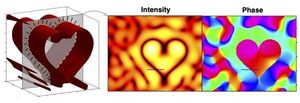
Harnessing the dark side
"Optical singularities could be used for a wide range of applications from super resolution imaging to optical trapping When we think about singularities, we tend to think of massive black holes in faraway galaxies or a distant future with runaway AI, but singularities are all around us. Singularities are simply a place where certain parameters are undefined. The North and South Pole, for example, are what’s known as coordinate singularities because they don’t have a defined longitude. Optical singularities typically occur when the phase of light with a specific wavelength, or color, is undefined. These regions appear completely dark. Today, some optical singularities, including optical vortices, are being explored for use in optical communications and particle manipulation but scientists are just begining to understand the potential of these systems." [...]
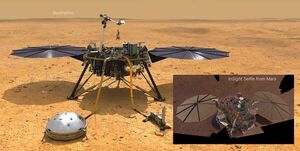
Advancing to the core thanks to marsquakes
"Researchers at ETH Zurich and the University of Zurich have been able to use seismic data to look inside Mars for the first time. Marsquakes recorded by NASA’s InSight lander provided information about the structure of the planet’s crust, mantle and core. We know that Earth is made up of layers: a thin crust of light, solid rock surrounds a thick mantle of heavy, viscous rock, which in turn envelopes a core consisting mainly of iron and nickel. Mars has been assumed to have a similar structure. “Now seismic data has confirmed our view that Mars is a differentiated planet that presumably was once completely molten before differentiating into crust, mantle and core – that are compositionally distinct like in the Earth,” says Amir Khan, a scientist at the Institute of Geophysics at ETH Zurich and at the Physics Institute at the University of Zurich. Together with his ETH colleague Simon Stähler and an international team, he analysed data from NASA’s InSight mission, in which ETH Zurich is participating under the leadership of Professor Domenico Giardini." [...]
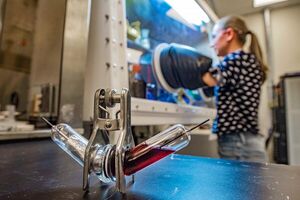
Sandia designs better batteries for grid-scale energy storage
"Sandia designs better batteries for grid-scale energy storage New molten sodium batteries operate at lower temperatures using low- cost materials Researchers at Sandia National Laboratories have designed a new class of molten sodium batteries for grid-scale energy storage. The new battery design was shared in a paper published today in the scientific journal Cell Reports Physical Science. Molten sodium batteries have been used for many years to store energy from renewable sources, such as solar panels and wind turbines. However, commercially available molten sodium batteries, called sodium-sulfur batteries, typically operate at 520-660 degrees Fahrenheit. Sandia’s new molten sodium-iodide battery operates at a much cooler 230 degrees Fahrenheit instead. “We’ve been working to bring the operating temperature of molten sodium batteries down as low as physically possible,” said Leo Small, the lead researcher on the project." [...]
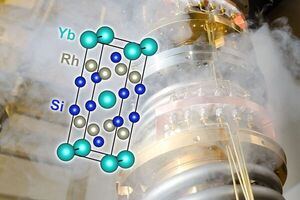
Using ultra-low temperatures to understand high-temperature superconductivity
"A surprising discovery at TU Wien could help solve the riddle of high-temperature superconductivity: A famous "strange metal" turned out to be a superconductor. At low temperatures, certain materials lose their electrical resistance and conduct electricity without any loss - this phenomenon of superconductivity has been known since 1911, but it is still not fully understood. And that is a pity, because finding a material that would still have superconducting properties even at high temperatures would probably trigger a technological revolution. A discovery made at TU Wien (Vienna) could be an important step in this direction: A team of solid-state physicists studied an unusual material - a so-called "strange metal" made of ytterbium, rhodium and silicon. Strange metals show an unusual relationship between electrical resistance and temperature. In the case of this material, this correlation can be seen in a particularly wide temperature range, and the underlying mechanism is known." [...]
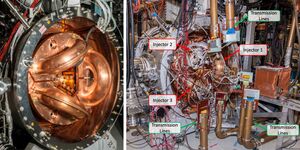
Gaming graphics card allows faster, more precise control of fusion energy experiments
"Nuclear fusion offers the potential for a safe, clean and abundant energy source. This process, which also occurs in the sun, involves plasmas, fluids composed of charged particles, being heated to extremely high temperatures so that the atoms fuse together, releasing abundant energy. One challenge to performing this reaction on Earth is the dynamic nature of plasmas, which must be controlled to reach the required temperatures that allow fusion to happen. Now researchers at the University of Washington have developed a method that harnesses advances in the computer gaming industry: It uses a gaming graphics card, or GPU, to run the control system for their prototype fusion reactor. The team published these results May 11 in Review of Scientific Instruments. “You need this level of speed and precision with plasmas because they have such complex dynamics that evolve at very high speeds." [...]

New quantum research gives insights into how quantum light can be mastered
"The breakthrough could have wide-reaching implications in quantum information, cryptography and energy harvesting, according to a new study A team of scientists at Los Alamos National Laboratory propose that modulated quantum metasurfaces can control all properties of photonic qubits, a breakthrough that could impact the fields of quantum information, communications, sensing and imaging, as well as energy and momentum harvesting. The results of their study were released yesterday in the journal Physical Review Letters, published by the American Physical Society. “People have studied classical metasurfaces for a long time,” says Diego Dalvit, who works in the Condensed Matter and Complex Systems group at the Laboratory’s Theoretical Division. “But we came up with this new idea, which was to modulate in time and space the optical properties of a quantum metasurface that allow us to manipulate, on-demand, all degrees of freedom of a single photon, which is the most elementary unit of light.” Metasurfaces are ultrathin structures that can manipulate light in ways not usually seen in nature. In this case, the team developed a metasurface that looked like an array of rotated crosses, which they can then manipulate with lasers or electrical pulses. They then proposed to shoot a single photon through the metasurface, where the photon splits into a superposition of many colors, paths, and spinning states that are all intertwined, generating so-called quantum entanglement—meaning the single photon is capable of inheriting all these different properties at once." [...]
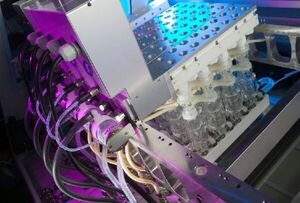
Researchers discover inorganic material with lowest thermal conductivity ever reported
"A collaborative research team, led by the University of Liverpool, has discovered a new inorganic material with the lowest thermal conductivity ever reported. This discovery paves the way for the development of new thermoelectric materials that will be critical for a sustainable society. The discovery, reported in the journal Science, represents a breakthrough in the control of heat flow at the atomic scale, achieved by materials design. It offers fundamental new insights into the management of energy. The new understanding will accelerate the development of new materials for converting waste heat to power and for the efficient use of fuels. The research team, led by Professor Matt Rosseinsky at the University’s Department of Chemistry and Materials Innovation Factory and Dr Jon Alaria at University’s Department of Physics and Stephenson Institute for Renewable Energy, designed and synthesised the new material so that it combined two different arrangements of atoms that were each found to slow down the speed at which heat moves through the structure of a solid." [...]
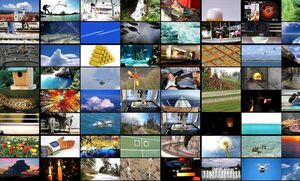
GPUs Can Now Analyze a Billion Complex Vectors in Record Time
"The advancement boosts the speed of GPU image analysis eight-fold The complexity of a digital photo cannot be understated. Each pixel comprises many data points, and there can be millions of pixels in just a single photo. These many data points in relation to each other are referred to as “high-dimensional” data and can require immense computing power to analyze, say if you were searching for similar photos in a database. Computer programmers and AI experts refer to this as “the curse of high curse of high dimensionality.” In a study published July 1 in IEEE Transactions on Big Data, researchers at Facebook AI Research propose a novel solution that aims to ease the burden of this curse. But rather than the traditional means of a computer’s central processing units (CPUs) to analyze high-dimensional media, they’ve harnessed Graphical Processing Units (GPUs). The advancement allows 4 GPUs to analyze more than 95 million high-dimensional images in just 35 minutes." [...]

Heisenberg under the microscope
"The quantum movements of a small glass sphere could be controlled for the first time in Vienna by combining microscopy with control engineering, setting the course for future quantum technologies. A football is not a quantum particle. There are crucial differences between the things we know from everyday life and tiny quantum objects. Quantum phenomena are usually very fragile. To study them, one normally uses only a small number of particles, well shielded from the environment, at the lowest possible temperatures. Through a collaboration between the University of Vienna, the Austrian Academy of Sciences and TU Wien, however, it has now been possible to measure a hot glass sphere consisting of about one billion atoms with unprecedented precision and to control it at the quantum level." [...]
Projetos Maker
Diversos Projetos interessantes.
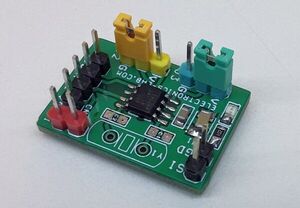
Clock Multiplier – Crystal Frequency Generator using PT7C4511
"This is an easy-to-build project and it is the most cost-effective and high-performance frequency multiplier, which instigates analog phase lock loop techniques. The circuit provides high-quality, high-frequency output from lower frequency crystal or clock input. The project can be used as a crystal frequency oscillator, clock multiplier and frequency translation. Using phase-locked-loop (PLL) techniques, the device uses a standard fundamental mode, inexpensive crystal to produce an output clock up to 200Mhz. On-board jumpers are provided to select from nine different multiplication factors, which output many common frequencies. The device also has an output enable pin that tri-states the clock output when the enable pin is taken low." [...]

Automatic Arduino Powered Camera Slider With Pan and Tilt
"Are you fed up of shaky footage that ruins your video? In this Instructable I attempt to address this issue by building my own automated camera slider. I used the power of CAD and digital fabrication to create a robust gantry system that rolls along a length of square tubing. The gantry holds a pan and tilt mechanism that gives the user the ability to shoot from any angle. The entire system is made using off the shelf parts such as stepper motors and Arduinos and it is designed to be easily transportable while being sturdy. Follow on to create your own Automatic Arduino Powered Camera Slider and do drop a vote for this project in the "Automation Contest" if you enjoyed the project and decide to build your own version." [...]
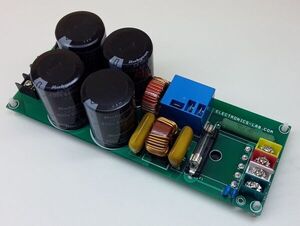
3 Phase AC input – DC Output – High Voltage DC Power Supply (2KW)
"Although this power supply design is specific to the Intelligent Power Modules (IPM) VFD drives, high voltage boost converters, high voltage battery chargers, etc, the concept and circuit design may be used for any power supply that requires a high voltage output of up to 800V DC and 4 A. Since it is an unregulated power supply the output will depend on AC input voltage. The circuitry includes a passive EMI filter consisting of elements C8, C9, C4, T1, and L1. Bridge rectifier D1, R1 for inrush current protection, and a relay RL1 for soft powering up and reducing conduction losses in steady-state. 4 x electrolytic capacitors C2, C3, C6, C7 are used for buffering the rectified DC bus voltage, bleeding resistors R1, and R2 provided to discharge the DC bus capacitor after power off. It is advisable to use a heatsink for the bridge rectifier." [...]

Kinetic & Digital Clock (Arduino + 3D Print)
"This is a seven segment clock where instead of LEDs we have segments moving on the Z-axis of the viewing pane, the difference in depth by these segments will allow the viewer to see the time against the white on white segments. We use an Arduino microcontroller to first process the read the current time and then align the segments out accordingly through a motor controller. This piece is a continuation of work I did previously out of paper. I bought a 3D printer to make this clock into a reality, as the precision and mechanical nature of this piece needed strong and reliable parts to create a clean finish and movement. Supplies Arduino Mega - The brain Arduino Mega Sensor Shield - The I/O DS3231 or RTC clock breakout - To keep track of time 30 Servos - To move each segment 3D Printer & Filament" [...]

Arduboy Extended
"Porting Arduboy to SAMD51 MCU and ILI9341 TFT display using Wio Terminal. Overview The Arduboy is a miniature credit card size game system with open source software, based on the Arduino hardware platform. I do not have an Arduboy but I feel nostalgic and love the retro gaming culture so I decided to make a handheld game console similar to Arduboy with extended screen size. Hardware selection In the beginning I thought I should be starting using a breadboard with an OLED screen and buttons and later move the design to a protoboard but due to limited time I decided to use Seeedstudio Wio Terminal which has SAMD51 microcontroller, ILI9341 color TFT display, 5-way switch and 3 push buttons. It has everything I needed to get started for rapid prototyping. Although, Wio Terminal has a color display but I wanted to keep the retro B/W look and feel." [...]

GRBL Based Coil Winder From Water Pipe
"When I was working on the Toy Magnetic Levitation project with a solenoid coil, I thought to myself, why didn't I make a coil winder. So I took my times to build a simple coil winder based on GRBL firmware and it was made from PVC pipes. I'm willing to share how I made it, please check out video below and let's get started. Main components: 1pcs x Arduino Uno R3 1pcs x Arduino CNC Shield V3 GRBL 2pcs x Stepper Motor Driver A4988 2pcs x Stepper motor NEMA 17 2pcs x GT2 6mm Closed Timing Belt 200mm 2pcs x GT2 Timing Pulley 60 Teeth, Hole diameter 8mm 1pcs x Round Bar Shaft Rod Diameter 8mm, Length 400mm 3pcs x Round Bar Shaft Rod Diameter 8mm, Length 200mm 1pcs x T8 Lead Screw 2mm Pitch, 8mm Lead , Length 400mm with Copper Nut 16pcs x F608ZZ Ball Flanged Shielded Bearings 8 x 22 x 7mm 2pcs x XH2.54mm – 4P Wire Cable Double Connector 1pcs x 5mm DC Female Power Plug 1pcs x Power Supply 12VDC 1pcs x Clear/White Acrylic, size A3, thickness 5~10mm 1pcs x Empty plastic spool. I reused empty plastic spool that is used to coil the soldering tin wires. 2pcs x Small Rubber Guide Roller V type." [...]
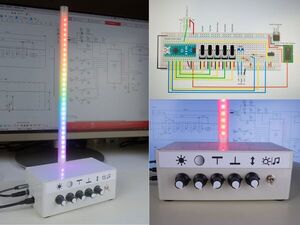
Audio Spectrum Visualiser with Colour Selection
"Choose the colours of the LED strip using Hue/Saturation/Value parameters, flick the switch and watch your music come to life through FFT. I was intrigued by the possibilities of addressable “Neopixel” RGB LEDs. I wanted to learn how to control them and to use them in a challenging project. I had read a few projects that use LED arrays and matrices to represent the audio spectrum, much like the illuminated displays on graphic equalizers. I thought of something a bit different. How about a vertical string of LEDs where the low frequencies would be at the bottom, the high frequencies would be at the top, and the amplitude of each frequency band would appear as the brightness of each LED?" [...]
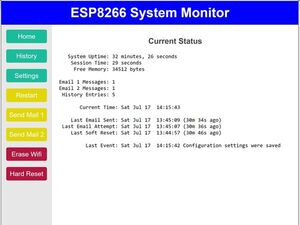
ESP8266 Starter System
"Self-contained starter system for ESP8266 projects. Includes a web console, web editable preferences system, event log, email capability Esp8266 Starter System - A Self-contained starter system for development of ESP8266 based projects System includes the following base capabilities WiFi support, including using WiFiManager to save credentials A simple LittleFS based preferences system with web edit/save of configuration file (for non-wifi settings) - A fully functioning system control website with 1) a system status view 2) a view/edit settings capability 3) an event history (logging) capability 4) some basic system controls (reset, clear WiFi settings, send email msg, etc) - Code to send email using smt2go.com smtp services as well as integration of email settings into preferences system - A simple event history system that records event messages strings along with a timestamp of when event happened - Misc date and time utilities to help with displaying current date and time and elapsedmillis timestamps Dependencies ESP8266WiFi, DNSServer, ESP8266WebServer, WiFiManager, NTPClient, WiFiClient, LittleFS, time.h, TZ.h ElapsedMillis All of these are likely available through the Arduino IDE Library Manager, but some may need to be installed by.zip files downloaded from github. I seem to have downloaded.zips for wifimanager, ntpclient, and elapsedmillis but I think they're all available through library manager now. This project was developed on a NodeMCU 1.0 ESP-12E module using the Arduino IDE 1.8.15, with this additional board manager: http://arduino.esp8266.com/stable/package_esp8266com_index.json The project implements a web control panel for management of the system All of the pages of the control website include a left-side button panel with buttons that either link to other pages of the system or invoke operations. " [...]
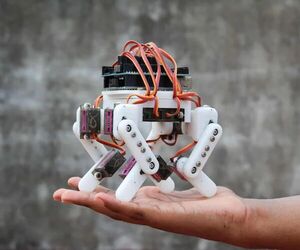
Arduino Powered Micro Quadruped
"From the previous projects on this page, you can probably see that I have a deep interest in robotic projects. In one of my previous Instructables, I built a quadruped robot using large heavy-duty servo motors, and this time I decided to try and make a micro version of the quadruped robot that is significantly more versatile and nimble. In this Instructable, I will show you the design and assembly of the robotic micro quadruped. The primary goal while building this project was to make the system as small as possible while being robust so that while experimenting with various walking and running gaits I wouldn't have to constantly worry about the hardware failing. This allowed me to push the hardware to its limit and experiment with complex gaits and motions. A secondary goal was to make the quadruped relatively low-cost using readily available hobby parts and 3D printing which allowed for rapid prototyping." [...]

DIY Arduino Musical Instrument-Theremin with 4 Sound Modes
"This instrument produces tones or sounds based on the light that falls on the surface of the photoresistor. The Theremin is an electronic musical instrument controlled without physical contact by the thereminist (performer). It is named after its inventor, Leon Theremin, who patented the device in 1928. This time I will show you how to make such an instrument that produces tones or sounds based on the light that falls on the surface of the Photoresistor. By moving your hand over the photoresistor, the intensity of light falling on it, changes, and that change the pitch. The device is very simple to build and can be successfully made by a beginner." [...]
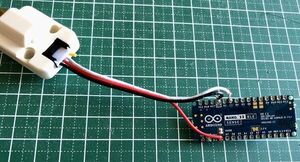
Snoring Guardian
"Using a Tensorflow Lite Micro model this edge device keeps an ear out and vibrates if you are snoring. Overview Snoring is estimated to affect 57% of men and 40% of women in the United States. It even occurs in up to 27% of children. These statistics demonstrate snoring is widespread, but its severity and health implications can vary. Snoring can be light, occasional, and unconcerning, or it may be the sign of a serious underlying sleep-related breathing disorder. Snoring is caused by the rattling and vibration of tissues near the airway in the back of the throat." [...]
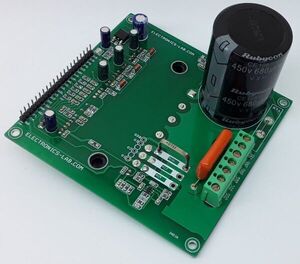
600V – 30A IPM Module Carrier Board for Variable Frequency Drive (VFD)
"This compact IPM module circuit provides a fully-featured, high-performance inverter output stage for AC Induction, BLDC, and PMSM motors. The circuit is based on FNA23060 chip which integrates the optimized gate drive of the built-in IGBTs to minimize EMI and losses, while also providing multiple on-module protection features: under-voltage lockouts, over-current shutdown, temperature sensing, and fault reporting. The built-in, high-speed HVIC requires only a single supply of 15V and translates the incoming logic-level gate inputs to high-voltage, high-current drive signals to properly drive the module’s internal IGBTs. On-Board optional current sense circuit can be used to monitor the current. LM317 regulator provides 5V DC output to drive op-amp current sense circuit. LED D4 and D5 indicate 5V power and 15V power." [...]

Running Faucet Alarm
"Detect running faucet using low powered i. MXRT1010 development board and Edge Impulse Studio. Overview Poor memory are only a few of the many unpleasant experiences that accompany old age and these problems can have far-reaching implications on the comfort and security of seniors. Dementia is one of the most common neurological problems associated with the elderly. Imagine a case of seniors leaving the faucet on. The kind of water damage that might ensue is simply unimaginable. Not to mention lots of safety concerns such as electrocution and drowning." [...]
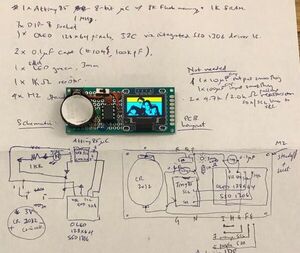
TinyPhoto: Embedded Graphics and Low-Fat Computing
"TinyPhoto is a small rotating photobook embedded graphics project that uses the low-power ATtiny85 microcontroller (3mA) and a 128×64 pixel OLED display (c.5-10mA typical, 15mA max). This combination can deliver at least 20 hrs of continuous play on a 3V coin cell battery (225mAh capacity). TinyPhoto can be readily built from a handful of through-hole electronic components (12 parts, £5) organized to fit onto a 3cm x 7cm single-sided prototype PCB. The embedded software is c.150 lines of C code and uses less than 1,300 bytes of on-chip memory. TinyPhoto rotates through five user-selectable images using a total of 4,900 bytes (yes, bytes!) stored in the on-chip flash RAM." [...]

Moodiest Display
"This is a WS2812B based Seven Segment Display aka Moodiest Seven Segment Display is designed to be the moodiest of all. You heard it right because it not only serves you a particular colour of light but the whole rainbow (VIBGYOR) effect and tons of animations. From this tutorial, you will be Learning- 1. How to design this Moodiest Seven Segment Display. 2. How to integrate animations and effects 3." [...]

DRAWING ROBOT, cheap and easy!
"I designed this drawing robot to be the simplest drawing robot you can build, still being VERY precise This drawing robot is designed to be one of the simplest drawing machine you can build, it is simple, easy to build, and very cheap. this project is suitable for everyone, from those who are just getting started, to the most expert ones, who want a simple and nice project. you can find every piece of information you need in the video above, thanks for watching and nice making!!! " [...]

The Hydrosys4 project
"The Hydrosys4 is an open source project which aims to provide automation tools for gardeners and farmers. It is specifically designed for irrigation and greenhouse automation. The system is based on the very popular and inexpensive raspberry PI computer board, (PI4, Pi3 or Pi0W). The project started as an irrigation system, then the it evolved to include many features relevant to automation and remote connection. Lately it has been optimized to automatically control mini-greenhouse environment, effectively becoming a quite complete control system for growers. Now the system is widely used with an active community and a forum: https://hydrosys4.wixsite.com/hydrosys4forum Unlike several other systems based on micro-controllers, the Hydrosys4 does not require any programming skills to be implemented, it is designed with a nice web interface." [...]
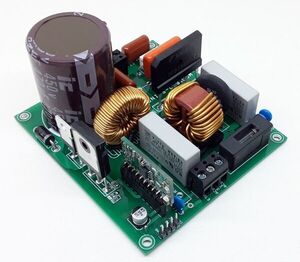
300W Off-line Power Factor Correction (PFC) Boost Converter
"The circuit presented here is a 300W off-line power factor correction (PFC) boost converter providing a nominal regulated output voltage of 375V @ 0.8A of load current. The project accommodates an input voltage range of 85V AC to 265VAC and uses average current mode control at a fixed programmable switching frequency of 116KHz. The project is based on UCCC28180 PFC controller module which incorporates a wide range of protection features to ensure safe system operation. The controller operates under average current mode control at a fixed programmable switching frequency of 116 kHz. Simple external current and voltage loop compensation, along with advanced protection features, make this controller ideal for server and desktop power supplies, industrial power supplies, and white goods. The project includes onboard fuse for short circuit protection, EMI filter, NTC to control inrush current, Bridge rectifier for DC rectification, high voltage/current MOSFET for switching, switching diode, high current inductor, high-value DC bus filter capacitor on the output." [...]
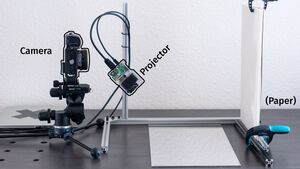
Rapid Prototyping Curved Mirrors
"Sometimes one may require a non-planar mirror. Usually you can do that by turning and polishing a chunk of metal on a lathe until it is so smooth that the metal works like a mirror. Or you can achieve a mirror surface by grinding a piece of glass or coating plastic in a vacuum chamber. All of that is pretty slow and expensive. But is there maybe an easier or faster way at the cost of a bit of precision? (yes) The material I use is laminated and metalized polystyrene." [...]
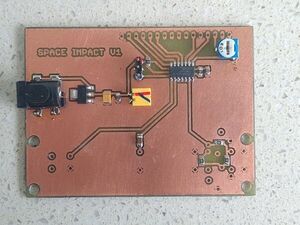
Tiny Space Invaders Game
"A battery or external powered LCD 1602 game console with built in Space Invaders and Space Impact games. Recently I did a project called Tiny Space Impact Game. After finishing it, I realized that the console itself was very generic and could be used for other LCD 1602 style games. Also there was plenty of unused Flash memory in the microprocessor to add more than just one game. Keeping with the space theme, I have added LCD Invaders by arduinocelentano along with a simple menu system to select the game. " [...]

Music & Lights Workbench for those new to programming
"Educational - to spark early interest in youngsters in computing, with easy constructions of cool music and light commands. Introduction The Music and Lights Workbench (MLWB) has been designed to introduce anyone new to or not familiar with the subject of computer programming. The approach taken is to provide a set of simple to use and logically applied commands (functions) that link the computer to the outside world through the playing of musical notes and/or the lighting of LEDs (lights). The MLWB commands are largely independent of each other and may be used for playing just music, illuminating just lights, or a combination of both. The MLWB does not require the use of any other programming functions, techniques or logic, just the simple statement of its commands. Whilst conditional constructs like if/then, do/while, for-loops, etc." [...]

Build Your Own DIY 3D-Printed Soldering Fume Extractor
"If you are an electronics hobbyist, soldering is essential in almost all of your project, but the smoke/fumes from burnt solder and flux isnt something you want to breathe. It smells bad and can be very dangerous to your health but you can reduce the hazards by employing a fume extractor. Even if you only solder things once in a while, it's a good idea to have a solder fume extractor to suck in those toxic fumes. If you want to buy a good fume extractor from the market, you have to pay more than $70. So I have made my own by using a 120mm PC cooling fan and 3D printed enclosure. I got the inspiration from the amazing 3D printed model designed by rdmmkr." [...]
Secção Videos
Videos interessantes.
That's all Folks!



